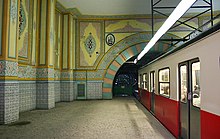Tunnel
The Tünel is an underground funicular in the European part of Istanbul and, with its opening in 1875, is considered the oldest permanent funicular in Europe , as the older Budavári Sikló in Budapest was temporarily out of service. It is considered to be the second oldest underground railway in the world after the London Underground . The train rises in a parabolic curve 61.55 m in height and runs over a distance of 606.50 m. It is a subway only in the sense that it is run underground, the drive technology is that of a pure funicular railway. It is one of the shortest subways in the world and is operated by the Istanbul local transport company İETT .
history
planning phase
In 1867, the French engineer Eugène-Henri Gavand identified the need for a fast connection between old Pera and the banks of the Golden Horn (Karaköy). It was more or less the continuation of the Orient Express ( Sirkeci terminus on the other side of the Horn) to the “European quarter” of the metropolis. As one possibility, he initially designed a kind of railway in the form of an escalator . After long deliberations, discussions and requests, on November 6, 1869, Sultan Abdülaziz gave him permission to build a tunnel . This tram continued up the mountain in the now nostalgic tram on İstiklal , the promenade in Pera in the direction of Taksim .
execution
After Gavand had found a foreign investor, the first work on the construction of the 573 meter long tunnel by The Metropolitan Railway of Constantinople from Galata to Pera began on July 30, 1871. The construction work could be completed on December 5, 1874. After the first test runs , the opening ceremony of the Tünel-Bahn took place on January 17, 1875. Initially, the railway was operated with a steam engine (110 kW). The chimney opposite the "mountain station" and the steam engine still exist.
The wagons were designed in such a way that they could transport horses and teams . In 1911 the license was transferred to the company Dersaadet Mülhakatindan Galata ve Beyoğlu Beyninde Tahtel 'arz Demiryolu . The city government bought the Tünel operating company on January 1, 1939 and transferred the operation to the newly founded İETT ( Istanbul Elektrik Tramvay ve Tünel ) on June 16, 1939 . During the Second World War , operations had to be suspended for three and a half months because some spare parts could not be obtained. After this time, Tünel was modernized by the French Electro Enterprise. The electrically powered wagons with 257 kW carried a maximum of 170 people per trip between the two stops in 90 seconds.
In the long operating history of the Tünel , one serious accident has occurred : after a cable of the funicular railway broke on July 6, 1943, the wagon drove down to the valley without braking at high speed. One person died and six were seriously injured.
Modernized railway in 1971
The electrification of the Tünel Railway was completed on November 3, 1971. Today, two vehicles with pneumatic tires are used, which run every two minutes, at peak times every 90 seconds. The maximum speed is 30 km / h, the cruising speed is 25 km / h. The double - track route became a single-track two - way traffic route with a turnout in the middle of the route ( Abtsche turnout ).
In 2007 tunnels were reinforced against earthquakes.
In total, the Tünel transports around 5.4 million passengers per year. It travels back and forth between the Karaköy valley station and the Tünel mountain station a total of 64,800 times a year , covering 37,066 kilometers.
literature
- Eugène-Henri Gavand: Chemin de fer métropolitain de Constantinople, ou Chemin de fer souterrain de Galata à Péra, dit tunnel de Constantinople. Projet d'une nouvelle ville et d'un nouveau port de commerce à Constantinople . Imprimerie de Lahure (1876), 43 pages.
Web links
- Tünel at funimag.com (English)
- Eren Kayaoğlu et al .: Early Application of Underground Funicular 'Tunnel' in Istanbul , March 2014, PDF (9 pages)
Footnotes
- ↑ Tünel Kronolojisi (Chronology of Tünel - Turkish)
Coordinates: 41 ° 1 ′ 35 ″ N , 28 ° 58 ′ 26.6 ″ E




